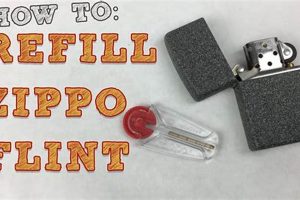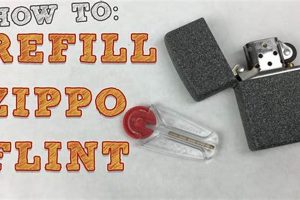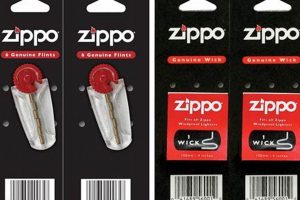Changing the sparking component in a Zippo lighter is a simple but essential maintenance task. This involves removing the spent component from the lighter’s insert and installing a new one to ensure reliable ignition.
A functioning igniter is crucial for the dependable operation of any lighter using this classic design. Regular maintenance, which includes this straightforward procedure, ensures consistent performance and prolongs the lifespan of the lighter. This process has remained largely unchanged since the lighter’s inception, reflecting its enduring practicality and ease of use.
The following sections will detail the necessary steps, tools, and tips for performing this crucial maintenance task effectively and safely.
Tips for Replacing a Zippo Lighter Igniter
Maintaining a Zippo lighter requires periodic replacement of its sparking component. The following tips ensure proper execution of this procedure.
Tip 1: Use the correct replacement component. Authentic components are recommended for optimal performance and longevity. Using generic components may lead to inconsistent sparking or damage the lighter.
Tip 2: Employ the proper tool. A small screwdriver or the bottom edge of a coin can be utilized to unscrew the retaining screw. Avoid using tools that could damage the screw or lighter casing.
Tip 3: Exercise caution when removing the spent component. The old component and spring are small and can be easily lost. Perform the replacement over a clean, well-lit surface to avoid misplacing these parts.
Tip 4: Insert the new component correctly. Ensure the new component is seated properly in its designated slot before replacing the retaining screw.
Tip 5: Secure the retaining screw firmly. The screw should be tightened snugly, but avoid overtightening, which could strip the threads or damage the lighter.
Tip 6: Test the lighter after replacement. Several test flicks confirm proper installation and functionality. If the lighter doesn’t ignite, recheck the component’s placement and the tightness of the screw.
Following these guidelines ensures reliable lighter function and extends the lighter’s lifespan. Proper maintenance contributes to the lighter’s continued dependable operation.
By adhering to these recommendations, users can maintain their lighters in optimal working condition, ensuring dependable ignition for years to come.
1. Unscrew the flint screw.
Accessing the flint compartment within a Zippo lighter requires the removal of the flint screw, a crucial initial step in the flint replacement process. This action allows access to the spent flint and its spring, enabling their removal and replacement with fresh components. Without unscrewing this screw, the replacement procedure cannot progress.
The flint screw acts as a gateway to the lighter’s sparking mechanism. Its removal is directly linked to the overall goal of restoring the lighter’s functionality. A worn flint renders the lighter inoperable. Therefore, unscrewing the flint screw initiates the necessary process of replacing the worn component and ensuring the lighter’s continued operation. This seemingly minor action plays a significant role in maintaining the lighter’s long-term reliability.
Successfully unscrewing the flint screw, while simple, is fundamental to the entire flint replacement operation. This step facilitates access to the core components responsible for the lighters ignition. Failure to properly remove the screw obstructs the entire process. Understanding the significance of this step underscores the importance of each individual action within a larger maintenance procedure.
2. Remove old flint.
Removing the spent flint is a critical stage in the “zippo replace flint” process. This action directly precedes the insertion of a new flint and is essential for restoring the lighter’s functionality. Without removing the depleted flint, the lighter remains unusable. This stage highlights the sequential nature of the maintenance procedure, where each step is crucial for achieving the desired outcome.
- Necessity of Removal
The old flint must be removed because it is no longer capable of producing the spark necessary for ignition. Its depletion renders it useless. This highlights the consumable nature of the flint and the need for regular replacement to maintain the lighter’s operation.
- Accessing the Flint Chamber
The flint chamber, typically located beneath the flint screw, becomes accessible once the screw is removed. This compartment houses the spent flint and spring. Access to this chamber is essential for completing the replacement process. This design element of the Zippo lighter underscores the importance of compartmentalization for maintenance.
- Handling the Spent Flint
Spent flints are small and can be easily lost. Careful handling during removal prevents misplacement. Working over a clean, well-lit surface is recommended. This emphasizes the need for attention to detail during the seemingly simple process of flint replacement.
- Preparing for the New Flint
Removing the old flint prepares the chamber for the insertion of a new one. This action creates the necessary space and ensures proper seating of the replacement flint. The removal of the old prepares the way for the new, highlighting the cyclical nature of maintenance.
These facets of removing the spent flint demonstrate its importance within the broader context of “zippo replace flint.” Each action contributes to the overall objective of maintaining the lighter’s functionality. The seemingly minor act of removing the old flint is integral to the successful completion of the replacement process and, ultimately, to the continued reliable operation of the Zippo lighter.
3. Insert new flint.
Inserting a new flint represents the core action within the “zippo replace flint” procedure. This step directly addresses the root cause of a failing lightera depleted sparking component. Cause and effect are clearly linked: the old flint no longer sparks, necessitating replacement with a new one to restore functionality. Without a fresh flint, the lighter remains inoperable, rendering the entire process pointless. The insertion, therefore, is not merely a step but the central act around which the entire procedure revolves.
Consider a scenario where a lighter fails to ignite. Troubleshooting reveals a worn flint. Procuring a new flint and properly inserting it into the flint chamber directly resolves the issue. This real-world example demonstrates the practical significance of “insert new flint” within the broader context. The act of insertion becomes the solution to the problem, effectively restoring the lighter to working order. This underscores the practical value of understanding this procedure.
In conclusion, “insert new flint” is inseparable from “zippo replace flint.” It is the pivotal action that directly addresses the functional deficiency caused by a depleted flint. Practical examples demonstrate the tangible impact of this step in restoring a lighter’s operation. Understanding the importance of this central action provides users with the knowledge and ability to maintain their lighters, ensuring reliable ignition when needed.
4. Replace flint spring.
Replacing the flint spring is integral to the “zippo replace flint” process. While the flint provides the sparking material, the spring provides the necessary pressure for the flint to engage with the sparking wheel. A weak or damaged spring can render a new flint ineffective, highlighting the interconnectedness of these components. Cause and effect are clearly linked: a failing spring results in inconsistent sparking or no spark at all, even with a new flint. Therefore, replacing the spring alongside the flint ensures reliable lighter function.
Consider a scenario where a lighter receives a new flint but still fails to ignite consistently. Investigation reveals a weakened spring unable to exert sufficient pressure on the flint. Replacing the spring, along with the flint, resolves the ignition issue. This practical example underscores the spring’s crucial role in the “zippo replace flint” procedure. Overlooking the spring can lead to persistent ignition problems despite installing a new flint, potentially misdiagnosing the problem. This underscores the practical significance of understanding the spring’s function and its replacement within the overall maintenance procedure.
In conclusion, “replace flint spring” is not merely a supplementary action but a critical component of “zippo replace flint.” The spring’s role in providing consistent pressure for spark generation is vital for reliable lighter operation. Practical scenarios demonstrate the consequences of neglecting spring replacement, highlighting its importance. Recognizing the integral function of the flint spring empowers users to perform comprehensive lighter maintenance, ensuring consistent ignition and prolonging the lighter’s lifespan.
5. Tighten the screw.
Securing the flint screw is the final step in the “zippo replace flint” process, completing the replacement procedure and ensuring the lighter’s functionality. This seemingly simple action plays a crucial role in maintaining the lighter’s structural integrity and operational reliability. An improperly tightened screw can lead to flint displacement, spring dislodgement, and ultimately, ignition failure. Cause and effect are directly linked: a loose screw compromises the entire flint replacement process, negating the effort of installing a new flint and spring.
Consider a scenario where a lighter undergoes flint replacement but subsequently experiences intermittent sparking or complete failure to ignite. Inspection reveals a loose flint screw, allowing the flint and spring to move out of position. Tightening the screw rectifies the issue, restoring consistent sparking. This practical example demonstrates the critical role of “tighten the screw” within the broader context of “zippo replace flint.” A loose screw can become the single point of failure despite a correctly installed new flint and spring, underscoring the importance of this often-overlooked step.
In conclusion, “tighten the screw” is not merely a concluding action but an integral component of “zippo replace flint,” ensuring the efficacy of the entire replacement process. The screw’s secure placement guarantees the stability and proper alignment of the newly installed components, directly impacting the lighter’s reliability. Practical scenarios highlight the detrimental effects of a loose screw, emphasizing its often-underestimated importance. Recognizing the crucial role of this final step empowers users to execute the “zippo replace flint” procedure effectively, guaranteeing consistent lighter performance and preventing future ignition issues.
6. Test the lighter.
Testing the lighter after flint replacement represents a critical verification step in the “zippo replace flint” process. This action confirms the efficacy of the entire procedure, validating that the new flint, spring, and screw are correctly installed and functioning as intended. Cause and effect are directly linked: successful ignition confirms a properly executed replacement, while failure to ignite indicates a potential issue within the process. Testing provides immediate feedback, allowing for prompt identification and rectification of any problems before relying on the lighter in practical situations.
Consider a scenario where a lighter undergoes flint replacement but does not produce a spark upon testing. This negative result signals a potential issue, such as an incorrectly installed flint, a damaged spring, or an improperly tightened screw. Retracing the steps and rectifying any errors ensures proper lighter function. This practical example demonstrates the diagnostic value of “test the lighter” within the “zippo replace flint” procedure. Testing transforms a potential future problem into an immediately addressable issue, preventing reliance on a malfunctioning lighter.
In conclusion, “test the lighter” is not merely a recommended afterthought but an essential component of the “zippo replace flint” process, providing critical feedback on the procedure’s success. This verification step confirms the lighter’s operational readiness, allowing for immediate troubleshooting and rectification of any issues. Practical examples underscore the diagnostic power of testing, highlighting its role in preventing reliance on a potentially faulty lighter. Integrating “test the lighter” into the “zippo replace flint” procedure ensures reliable lighter function and reinforces the importance of verifying maintenance procedures for optimal performance and dependability.
7. Proper flint disposal.
Proper flint disposal, while often overlooked, represents a responsible concluding action within the broader context of “zippo replace flint.” This seemingly minor act demonstrates environmental awareness and responsible ownership, completing the entire process from replacement to disposal. Although small, spent flints contribute to metal waste if discarded improperly. Understanding proper disposal methods minimizes environmental impact and promotes responsible lighter maintenance practices.
- Environmental Responsibility
Discarded flints, though small, contribute to metal waste. Proper disposal minimizes environmental impact by preventing these small metal components from ending up in landfills or as litter. This highlights the user’s role in responsible waste management, even for seemingly insignificant items. Choosing appropriate disposal methods, such as designated metal recycling bins, demonstrates environmental consciousness.
- Material Composition
Flints are typically composed of ferrocerium, a pyrophoric alloy containing iron and cerium. Understanding the material composition informs appropriate disposal choices. Recognizing that flints contain metals reinforces the need for recycling rather than simply discarding them in general waste. This knowledge empowers users to make informed decisions about disposal methods.
- Disposal Methods
Several disposal options exist for spent flints. Designated metal recycling bins offer an environmentally sound solution. Alternatively, some municipalities accept small metal items in curbside recycling programs. Researching local regulations provides clarity on acceptable disposal methods. This underscores the importance of local awareness and responsible adherence to waste management guidelines.
- Integration with “Zippo Replace Flint”
Proper flint disposal logically concludes the “zippo replace flint” process. It represents the final act of responsible lighter maintenance, demonstrating consideration for both functionality and environmental impact. Integrating proper disposal into the overall procedure promotes a holistic approach to lighter care, emphasizing responsible ownership from start to finish.
In conclusion, proper flint disposal, though a small action, represents a significant component of responsible lighter ownership. Integrating this practice within the “zippo replace flint” process elevates the entire procedure beyond mere maintenance, demonstrating environmental awareness and a commitment to responsible waste management. By understanding and applying appropriate disposal methods, users contribute to a more sustainable approach to lighter use and exemplify responsible ownership.
Frequently Asked Questions
This section addresses common inquiries regarding Zippo lighter flint replacement, providing clear and concise information to ensure proper maintenance and optimal lighter function.
Question 1: How frequently should a Zippo lighter’s flint be replaced?
Flint replacement frequency depends on usage. Heavier use necessitates more frequent replacement. A general guideline suggests replacement every few weeks with regular use. Observing diminished spark quality indicates the need for replacement.
Question 2: What type of flint is recommended for Zippo lighters?
Authentic Zippo flints are recommended for optimal performance and longevity. Generic flints may not meet Zippo’s quality standards and could potentially damage the sparking wheel. Using genuine Zippo flints ensures consistent sparking and prolongs the lighter’s lifespan.
Question 3: Can one damage a Zippo lighter by replacing the flint incorrectly?
While the process is straightforward, incorrect flint replacement can potentially lead to issues. Forcing the flint or using excessive force on the flint screw can cause damage. Following the recommended procedure mitigates the risk of damage.
Question 4: What indicates a need for flint replacement beyond diminished spark?
Complete absence of a spark, even with repeated flicks, typically signifies a depleted flint. Additionally, a grinding sensation when operating the lighter suggests the flint is worn down and requires replacement. These indicators offer clear signals for necessary maintenance.
Question 5: What tools are necessary for flint replacement?
A small screwdriver, specifically a flathead screwdriver, or the edge of a coin suffices for removing and tightening the flint screw. Specialized Zippo tools are also available, offering enhanced convenience and precision. However, basic tools are often sufficient for this simple procedure.
Question 6: How should spent flints be disposed of properly?
Spent flints should be disposed of responsibly due to their metal content. Recycling through designated metal recycling programs or adhering to local waste management guidelines for small metal items is recommended. This practice minimizes environmental impact and promotes responsible lighter maintenance.
Understanding these frequently asked questions equips users with the knowledge necessary for proper and effective flint replacement, contributing to the longevity and dependable performance of their Zippo lighters.
The next section provides a step-by-step visual guide to replacing the flint in a Zippo lighter.
Zippo Replace Flint
Maintaining a Zippo lighter’s functionality relies significantly on the regular replacement of its flint. This seemingly minor procedure ensures reliable ignition, demonstrating a direct link between proper maintenance and consistent performance. This article explored the critical aspects of flint replacement, from understanding the function of the flint and spring to the practical steps involved in their replacement, emphasizing the importance of each action within the overall process. Proper flint replacement, combined with responsible disposal, contributes not only to the lighter’s longevity but also reflects conscientious ownership and environmental awareness. Understanding and executing this straightforward procedure empowers users to maintain their lighters’ dependable performance, underscoring the value of routine maintenance in ensuring a functional and reliable tool.
The ability to replace a flint correctly empowers users to maintain a crucial tool’s functionality. Regular maintenance ensures consistent performance and reflects responsible ownership, extending the lifespan of a well-crafted instrument. This seemingly simple act of replacement embodies the practical value of understanding a tool’s mechanics, allowing for continued dependable operation. The continued use of classic, refillable lighters represents a sustainable practice, further emphasizing the importance of understanding basic maintenance procedures.







